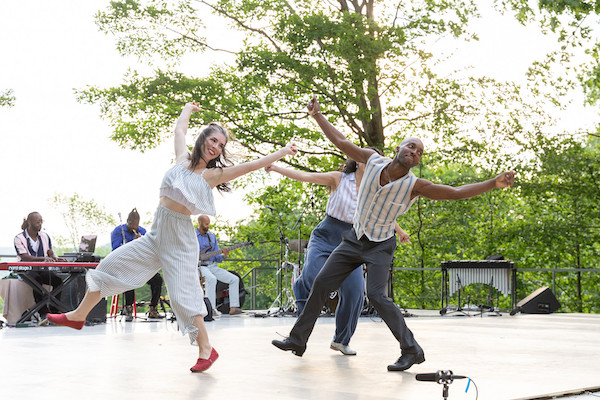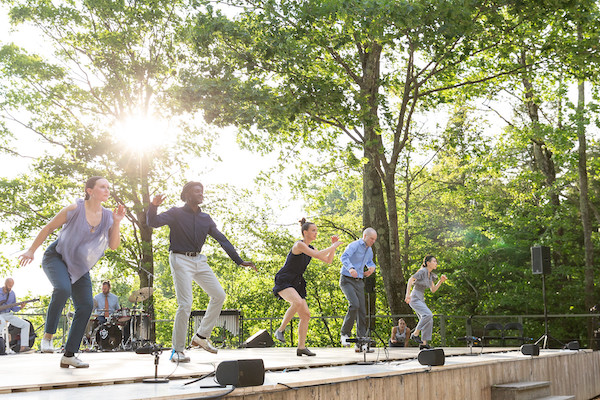Dance Review Flashback: The Irrepressible Dorrance Dance at Jacob’s Pillow
By Thea Singer
I can still feel the exhilaration, the rush of the opening of things, from that day.

Carson Murphy, Claudia Rahardjanoto, and Byron Tittle of Dorrance Dance in “…Praise: The Inevitable Fruit of Gratitude” performed in the opening week of Jacob’s Pillow Dance Festival 2021. Photo: Jamie Kraus.
FLASHBACK, BECKET — Live dance that elicits soul-stirring rhythms accompanied by on-stage musicians playing their hearts out after two years of virtual performances was enough to make the sun come out at Jacob’s Pillow on July 4 after four days of rained-out shows. The troupe sending those notes, and sparks of light, from the Henry J. Lier Outdoor Stage was the irrepressible Dorrance Dance. Seated in the dell on pine benches, surrounded by tall oaks and gazing out at the Berkshire Hills, we took off our masks, and breathed. Independence Day, indeed.
So I began my review of the inaugural show at the Pillow’s on-site 2021 season. Soon after, I had to return to the office for my day job despite the Delta variant’s surge, and fear threw me way off track. Please forgive me for the delay. The memory of the two remarkable Dorrance dances on display — “Untitled Waveforms” and excerpts from “…Praise: the Inevitable Fruit of Gratitude” — helped bring me back.
History lies in the bones of the troupe’s 15 dancers: they at once echo and expand on the Black vernacular traditions of their rhythmic-tap forebears, among them the legendary Jimmy Slyde, Fayard and Harold Nicholas, Charles “Honi” Coles, and (still with us) Dianne Walker. Moving from the core, they use every part of the foot — side, sole, arch, ball, heel, toe, you name it — to create music. The body follows suit. An arm flips skyward because a rhythmic impulse — driven by the chase of a particular sound — sends it soaring. Momentum, tempered by creative intent, begets shape.
The ricocheting feet and wide-flung limbs, the counterpoint claps and thickening and thinning of dynamics and stage space, now catapult you from your seat, now leave you with a catch in your throat. The dances are simultaneously a commentary on our times and a celebration of community born of the creative contributions — some choreographed, some improvised — of each individual dancer.
“Untitled Waveforms,” an explosion of tap-induced polyrhythms, perfectly fits that bill. A world premiere for 10 choreographed by Nicholas Van Young and rich with improvisation, it conjures, through sound and vibrating images, the isolation and uncertainty — the sense of order undone — of this past pandemic year. The music, composed and played by Donovan Dorrance (piano), Aaron Marcellus (vocals, keyboard), Gregory Richardson (electric and upright bass), and Young (drums), runs like a sine curve — from wistful to high-spirited — through the dancers’ own acoustic accelerations and denouements.

Warren Craft and Rena Kinoshita of Dorrance Dance in “Ways to Now,” performed on the Jacob’s Pillow Grounds in the opening week of Festival 2021. Photo by Christopher Duggan.
The piece begins with riffs passed around a circle, person to person, as in a game of telephone with each click and slide and rat-a-tat-tat as articulate as the last and resonant with each dancer’s tweaks. Forms coalesce and break apart: it’s a kaleidoscope of sound and shapes — clacking, clapping, shuddering, sliding, now syncopated, now one displacing the other, now a united revelry.
Permutations in numbers and placement abound. Lined up vertically, five on stage left, five on stage right, they face each other. In crossing, some backwards, some forward, they egg each other on, with the music a carpet beneath their fibrillating feet.
Then the core of the piece comes to the fore. Nine dancers form a line stage left, backs to us. A solitary man circles centerstage, skitters on the diagonal, travels with crisscrissing feet, dissolves into running in place. The nine in the line turn to face him: they are bearing witness to his untethering and in the process recognizing their own. Traveling across the space as a unit, they absorb him in their midst.
The sequence repeats, but with different dancers dropping out, one by one, to tell their stories. Elizabeth Burke, in suspender pants and flowered shirt, sends one foot chattering: the echoes land like teardrops. Michelle Dorrance, in orange shirt and black-and-white checked pants, appears broken, all angles, jolted by strings, until she gathers herself up, circling slowly. Brian Tittle, usually all warmth and bounce, holds still as the others walk around him—just people passing in the street. Aaron Marcellus, keyboardist and singer, approaches him: “You’ll be taken care of,” he sings. Then: “I’ll be giving love.”
Release! Tittle, now at play, spins, gallops, slides. Couples join in. The opening circle reappears, once again passing the “word” in reverberating feet, polyrhythmic claps, torsos leaning in. Together, in rollicking, rocketing three dimensions again (no Zoom squares here): “We’re back.”
The second piece, pre-premiere excerpts from “…Praise: the Inevitable Fruit of Gratitude,” carries that sentiment forward, with reverence. It could be read as a “response” to the “call” of “Untitled Waveforms”—an echo, writ large, of the vibrant “call and response” footwork that’s a staple of the artform.
A rhythmic exploration of gratitude for 14, “Praise” was choreographed by Josette Wiggan-Freund in collaboration with the dancers, with original moves by b-girl Ephrat Asherie and b-boy Matthew West. Jazz trumpeter extraordinaire Keyon Harrold composed the score. Alternately playing solo and accompanied by the Dorrance Dance ensemble of piano, guitar, keyboard, bass, drums, and vocals, Harrold fills the glorious mountain air with elongated plaintive chords, accelerating riffs, and a hallelujah chorus of bodies, souls, and voices.

Dorrance Dance in “…Praise: The Inevitable Fruit of Gratitude,” performed in the opening week of the Jacob’s Pillow Dance Festival 2021. Photo by Jamie Kraus.
Those voices resonate in words and in sound made visible as the dancers move out of the overall storyline to tell their own tales — some in solos, some in duets or trios. They’re like characters in a play breaking through the fourth wall telling us about their reactions.
“For me, the definition of praise acknowledges something bigger than me and gratitude for that…knowing I’m not carrying the burden…” says one dancer in a voiceover. “When I hear praise, we are all worthy to celebrate and amplify the joy in our lives no matter how big or small,” says another. “To walk away from one stage of life to another…change is where the victory lies,” notes a third.
Joy takes flight. A pair converses in double time, limbs flying. Two parallel lines of five, stretched horizontally across the stage, jauntily cross, the front line filling the negative spaces of the back line, and vice versa. Later, everyone in synchrony, scattered, spins with open arms, hops on one foot, flings legs fore and aft, before turning to face the Berkshire Hills. You can almost hear the child’s refrain: “Again! Again!”
The rhythmic complexity astounds. Three couples rip through points and counterpoints, aurally shattering eggshells before drifting into long, slow ronds de jambes. Warren Craft, tall and angular, whips about as if out of control until an elbow to a hip grinds him to a stop. Wiggan-Freund executes a magnificent solo in a long dark skirt slashed by white. Her feet are a blur of movement, with beats and smacks shifting into slides, upswung arms, and knees angling high. Harrold approaches with his trumpet, and she spun into butter.
Another voiceover: “To me, feeling good is movement.”
I can still feel the exhilaration, the rush of the opening of things, from that day. Talk about gratitude…
Thea Singer is a longtime dance critic and science writer based in Brookline, Mass. Her articles have appeared in numerous publications including the Washington Post, Boston Globe, Scientific American, MORE magazine, O the Oprah magazine, Psychology Today, Huffington Post, Boston magazine, the Daily Beast, and Nature Outlook.
Tagged: Byron Tittle, Carson Murphy, Claudia Rahardjanoto, Dorrance Dance, Jacobs-Pillow-Dance-Festival
